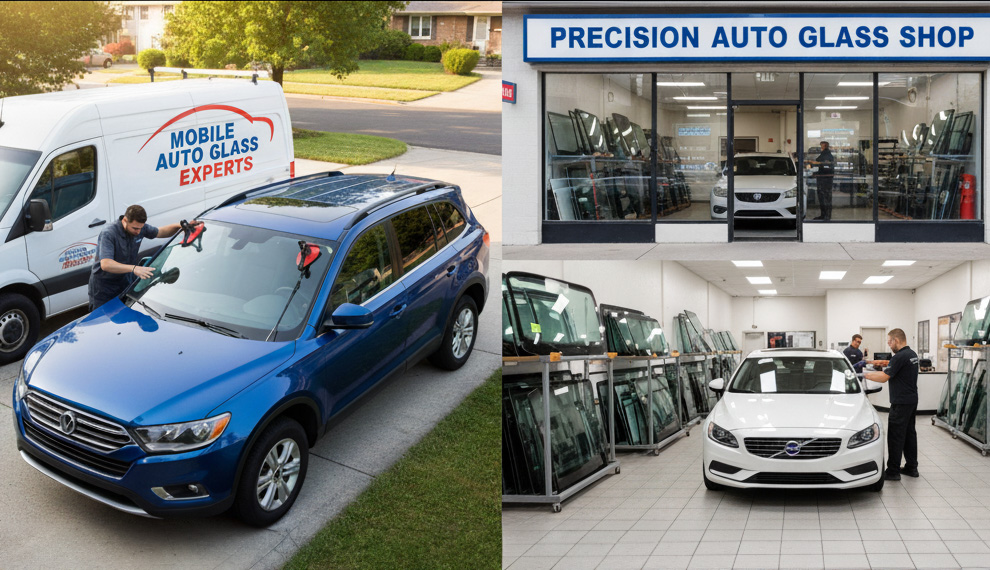When your windshield is cracked beyond repair, the next step is a full replacement, but deciding where to have it done can be tricky. Should you schedule a mobile windshield replacement, where a technician comes to you, or visit a repair shop for in-house service?
Both options offer advantages depending on your vehicle type, damage severity, and lifestyle. In this article, we’ll explore the pros and cons of mobile and in-shop windshield replacement, discuss how advancing automotive technology affects your decision, and explain how to find the best professionals near you.
Why Proper Windshield Replacement Matters
Your windshield is a vital safety feature of your vehicle—not just a piece of glass. It:
- Provides up to 60% of cabin structural integrity during rollovers.
- Supports airbag deployment in many vehicles.
- Houses ADAS sensors and cameras that power safety systems like lane assist and automatic braking.
A poor-quality replacement can cause water leaks, wind noise, misaligned sensors, or even ADAS malfunctions—all of which can compromise your safety. That’s why choosing the right replacement service and environment is critical.
Mobile Windshield Replacement: Ultimate Convenience
Mobile windshield replacement allows a certified technician to come to your home, office, or other convenient location. It’s a lifesaver if your windshield damage makes driving unsafe or if you simply can’t find time to visit a shop.
Pros of Mobile Windshield Replacement
- Convenience and Time-Saving – No driving or waiting; service comes to you.
- Safer for Severe Damage – Avoids driving with a shattered or structurally weak windshield.
- Flexible Scheduling – Perfect for busy professionals or families.
- Same Quality Glass and Materials – Certified mobile technicians use the same OEM-quality glass as shops.
Cons of Mobile Windshield Replacement
- Weather Limitations – Rain, humidity, or cold can affect adhesive curing.
- Limited Calibration Capability – ADAS recalibration often requires special equipment available only in-shop.
- Setup Constraints – Uneven surfaces or poor lighting can affect installation accuracy.
- Cure Time Sensitivity – Outdoor temperature can impact how quickly urethane adhesives bond and cure.
Mobile replacement is best suited for non-ADAS-equipped vehicles or when you need quick, on-site help in mild weather conditions.
In-Shop Windshield Replacement: Precision and Technology
In-shop windshield replacement remains the most reliable option for vehicles with ADAS, panoramic glass, or complex windshield designs.
Pros of In-Shop Windshield Replacement
- Controlled Environment – Ideal temperatures and lighting ensure precise installation.
- Advanced Calibration Tools – Shops are equipped to perform both static and dynamic ADAS recalibrations after replacement.
- Better Quality Control – Technicians can double-check curing, sealing, and sensor alignment.
- Access to Specialty Equipment – Lifts, diagnostic computers, and drying systems enhance accuracy and safety.
Cons of In-Shop Windshield Replacement
- Less Convenient – Requires traveling to the shop and waiting for service.
- Appointment Delays – Some shops have longer wait times, especially for specialty glass.
- Transportation Risk – Driving with a severely cracked windshield can be unsafe or illegal in some states.
If your vehicle has modern driver assistance features—or if you simply want maximum assurance of quality—in-shop replacement is often the better choice.
How Technology Has Changed Windshield Replacement
Today’s vehicles aren’t just windshields with wipers—they’re technology-integrated systems. Many modern cars include:
- Cameras and sensors for lane departure warnings and automatic braking.
- Rain and light sensors for automatic wipers or headlights.
- Heads-up displays (HUDs) projected directly on the glass.
These features require precise windshield alignment and post-installation calibration to function safely. In-shop replacements are better equipped for these steps, although some advanced mobile units now carry portable calibration systems—a growing trend in the industry.
Additionally, new urethane adhesives cure faster and bond stronger than ever before, allowing mobile replacements to achieve near shop-level reliability when conditions are right.
Which Windshield Replacement Option Is Right for You?
| Situation | Best Option | Why |
| Severe windshield damage | Mobile replacement | Avoids driving with unsafe glass |
| ADAS-equipped vehicle | In-shop replacement | Allows full calibration and testing |
| Bad weather conditions | In-shop replacement | Controlled environment ensures proper curing |
| Busy schedule | Mobile replacement | Saves time and travel hassle |
| Seeking the highest precision | In-shop replacement | Full access to tools and diagnostics |
Final Thoughts
Whether you choose mobile or in-shop windshield replacement, what truly matters is the quality and expertise of the technicians handling your vehicle. A properly installed windshield ensures clear visibility, safety system accuracy, and long-term durability.
Before booking your replacement, take a few minutes to compare your options.Use Glass.net’s free quote tool to compare up to three trusted windshield replacement shops near you. You’ll find certified professionals, transparent pricing, and services tailored to your vehicle’s specific needs, so you can get back on the road safely and confidently.

To read more, visit blog.glass.net

